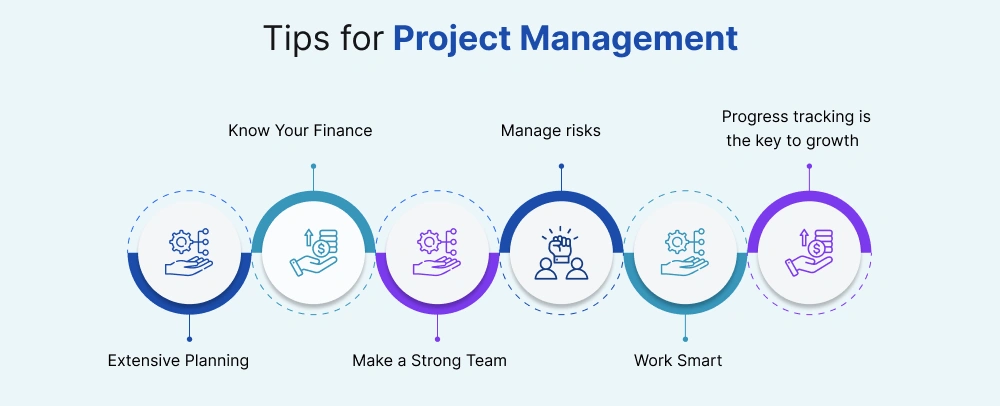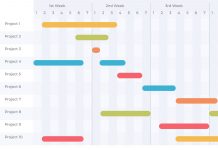
The success of a project often hinges not on the tools or timelines, but on whether everyone is clear about what they’re accountable for.
That’s harder than it sounds.
In fast-moving, cross-functional teams, project team roles and responsibilities can blur quickly. A product owner may also serve as a client liaison. Developers may be looped into strategy conversations. And before long, decisions stall, tasks fall through the cracks, or multiple people unknowingly work on the same thing.
| Did You Know?
70% of projects fail to meet their goals, and beneath many of those failures lie vague responsibilities, overlapping duties, and a lack of team alignment. |
Table of Contents
- Introduction
- Key Roles in a Project Team with Responsibilities
- Role Clarity in Different Project Structures
- Common Challenges and Solutions in Project Team Management
- Best Practices for New Project Managers
- Conclusion
If you’ve ever found yourself wondering who’s actually in charge of a deliverable or stepping in to fix misaligned expectations mid-project, you’re not alone. This blog helps you get ahead of those issues.
We’ll break down project team roles and responsibilities across modern and hybrid environments, showing how accountability shifts with different team structures. You’ll also learn practical strategies for defining roles clearly, improving team collaboration, and creating a sense of ownership among team members, so everyone is aligned and ready to contribute effectively from day one.
Key Project Team Roles and Responsibilities
Behind every successful project is a team that doesn’t just execute tasks, but clearly understands the purpose behind them, how they fit together, and who is responsible for what. According to McKinsey & Company, organizations with well-defined project objectives are 70% more likely to deliver successful outcomes. At the heart of that success lies role clarity: knowing not just what needs to be done but who is accountable at every stage.
In this section, we break down the core project team roles and responsibilities that form the foundation of any well-run project, regardless of its size, scope, or industry.
1. Project Sponsor – The Strategic Investor Behind the Vision
Role: Executive Champion | Strategic Enabler | Decision-Maker
Why is this project being done, and what business value does it drive?
| Did You Know?
Research indicates that two-thirds of projects have engaged project sponsors. |
The project sponsor serves as the organizational advocate for the project. Often, a senior executive, the sponsor, secures the budget, defines the strategic direction, and ensures leadership alignment. While not directly involved in the day-to-day operations, their engagement is mission-critical, especially when tough trade-offs or executive decisions are required.
Sponsors hold the power to unblock bureaucracy, approve major shifts, and protect the project from being derailed by competing priorities.
Key Responsibilities:
- Define and communicate the project’s vision and value proposition clearly and effectively
- Secure and allocate funding, resources, and executive-level support
- Resolve high-level roadblocks beyond the PM’s authority
- Approve scope, timeline, and budget changes
- Provide guidance and political backing throughout the project lifecycle
- Make final decisions on project priorities and trade-offs when resource allocation is contested
2. Project Manager – The Conductor of the Entire Delivery Orchestra
Role: Operational Leader | Integrator | Risk Navigator
How do we deliver the project on time, on scope, and on budget?
The project manager (PM) is the one who converts a vision into a plan and then leads the execution of that plan. Think of them as the integrators across people, processes, and progress. They manage the scope, coordinate teams, report to stakeholders, and adjust when reality collides with planning.
| Did You Know?
According to recent research, 82% of high-performing companies rely on certified project managers to run critical initiatives. |
PMs are not just task managers; they must master stakeholder communication, risk mitigation, emotional intelligence, and decision-making under pressure.
Key Responsibilities:
- Develop and maintain the project charter, plan, and schedule.
- Define deliverables, milestones, and critical paths.
- Build, lead, and motivate the project team.
- Manage scope, budget, risks, and issues.
- Track progress and report to stakeholders.
- Facilitate standups, reviews, and retrospectives.
- Serve as the communication bridge across stakeholders and teams.
3. Business Analyst – The Translator of Complexity into Clarity
Role: Value Maximizer | Requirement Translator | Process Expert
What exactly are we building, and what problem does it solve?
The business analyst (BA) serves as a bridge between stakeholders and the technical team. They elicit needs, define requirements, and ensure the solution aligns with business objectives. In agile teams, this role often overlaps with the product owner or requirements engineer.
BAs must operate in ambiguity, translating fuzzy stakeholder ideas into structured, testable deliverables. They ensure everyone is building the right thing before building it right.
| Did You Know?
According to PMI, 37% of failed projects are the result of poor or misunderstood requirements, underscoring the critical role BAs play. |
Key Responsibilities:
- Gather, document, and validate functional and non-functional requirements.
- Facilitate workshops, interviews, and requirement elicitation sessions.
- Conduct stakeholder analysis and map customer journeys.
- Translate high-level needs into actionable specs for the technical team.
- Perform gap analysis and propose solutions.
- Support user acceptance testing and solution validation.
4. Project Team Members – The Builders, Specialists, and Executors
Role: Deliverable Owners | Task Executors | Knowledge Contributors
What work needs to be done, and who is responsible for doing it?
These are the individuals—designers, developers, testers, writers, and engineers —who directly execute the project’s deliverables. They bring their domain expertise to contribute tangible outcomes and often work across sprints, phases, or functional units.
| Did You Know?
A Geneca study found that 80% of rework in projects results from misaligned team understanding, not poor performance. Active engagement of team members early in planning helps avoid this. |
Team members are closest to the work. They’re often the first to detect issues, propose solutions, and validate feasibility before problems escalate.
Key Responsibilities:
- Execute assigned tasks according to scope, schedule, and quality expectations.
- Collaborate with peers to solve problems and meet dependencies.
- Communicate status updates, risks, and blockers to the project manager.
- Document learnings and contribute to knowledge sharing.
- Participate in retrospectives, reviews, and continuous improvement.
5. Resource Manager – The Strategist of Talent and Capacity
Role: Workforce Strategist | Capacity Planner | Talent Enabler
Do we have the right skills available at the right time to meet delivery goals?
| Resource planning is becoming more important as organizations focus on optimizing their workforce. Project managers are more likely to prioritize resource management in their planning processes. |
The resource manager ensures that each project has the appropriate staffing mix, without overloading people or creating resource conflicts. Especially in matrix organizations or PMOs, they act as liaisons between functional departments and project teams.
Resource managers must anticipate talent gaps before they become delivery blockers. Their work requires forecasting, negotiation, and constant reprioritization.
Key Responsibilities:
- Maintain a real-time view of talent availability, workload, and skills inventory.
- Allocate team members to projects based on skills, availability, and priority.
- Balance competing demands across projects and departments.
- Monitor utilization, capacity, and burnout risks.
- Coordinate onboarding/offboarding of project resources.
Specialized Project Roles and Responsibilities
Not all projects require the same personnel mix. In complex or high-stakes environments, specialized roles extend the capabilities of core teams, filling critical gaps in expertise, compliance, governance, and stakeholder engagement.
These are the strategic enablers, advisors, architects, compliance officers, and cross-functional specialists who ensure the project can adapt to technical, regulatory, or market-specific demands.
To build a truly resilient delivery ecosystem, it’s essential to understand the roles involved, when they’re needed, and how they contribute.
1. Subject Matter Expert (SME)
Key Role: Deep domain expertise to guide decisions and ensure accuracy
SMEs are often called in to validate feasibility, solve problems, or provide advice on complex requirements, whether in finance, healthcare, cybersecurity, or any other regulated field. Their role is not day-to-day execution but targeted intervention.
Responsibilities:
- Validate business and technical requirements for accuracy and feasibility
- Offer insights based on the latest trends, industry standards, or regulatory mandates
- Participate in solution design reviews to prevent misalignment or technical flaws
- Provide clarity during ambiguity or complexity in decision-making
- Support stakeholder communication by explaining technical implications in business terms
- Assist in training, documentation, and knowledge transfer to internal teams
2. Change Control Board (CCB) Member
Key Role: Governance of project scope and change management
For large-scale or compliance-heavy projects, changes to scope, budget, or timelines must be formally reviewed and approved. The CCB ensures that the project scope isn’t altered without adequate assessment and approval.
Responsibilities:
- Review and evaluate change requests against business objectives, resource impact, and timeline
- Ensure proposed changes are documented, justified, and supported by data
- Approve or reject changes through a formal voting or consensus process
- Analyze the cumulative effect of changes on the project baseline (cost, schedule, risk)
- Maintain an audit trail of all scope modifications for governance and compliance
- Communicate approved changes clearly to stakeholders and implementation teams
3. Project Management Office (PMO)
Key Role: Standardization, oversight, and portfolio alignment
| PMI’s Pulse of the Profession report found that 65% of projects at organizations with a PMO were successful, compared to 56% at those without one. |
A PMO provides frameworks, tools, templates, and governance across multiple projects. It serves as a centralized function to ensure consistency, improve resource utilization, and provide executive visibility.
Responsibilities:
- Define and maintain project management methodologies, templates, and best practices
- Train and mentor project managers and teams on tools, techniques, and reporting
- Track project performance metrics (KPIs) across the portfolio
- Ensure resource optimization by balancing workloads and availability
- Conduct project audits and reviews to ensure compliance and performance
- Serve as a centralized source of project-related data for executive decision-making
- Manage organizational project repositories and knowledge bases
4. Steering Committee Member
Key Role: Strategic oversight and executive guidance
Steering committees are made up of executives and sponsors who ensure the project remains aligned with business objectives. They’re essential in programs involving multiple stakeholders or business units.
Responsibilities:
- Validate the project’s alignment with strategic goals and ROI expectations
- Resolve escalated issues related to scope, resources, or interdependencies
- Review key milestones and sign-off on phase gate deliverables
- Make go/no-go decisions based on risk assessments and business readiness
- Approve additional funding or timeline adjustments if required
- Ensure cross-functional collaboration among departments and external partners
- Act as champions for the project at the executive and board levels
5. Risk Manager / Compliance Lead
Key Role: Proactive identification and mitigation of risks
| Did You Know?
62% of risk and compliance teams have increased in size due to in-sourcing efforts. |
In regulated or high-risk environments, dedicated risk and compliance roles track threats, technical, legal, and operational, before they derail progress.
Responsibilities:
- Develop a comprehensive risk management plan and update it throughout the project lifecycle.
- Perform risk assessments and categorize risks based on likelihood and impact.
- Define mitigation and contingency strategies with the responsible owners.
- Monitor legal, environmental, data privacy, or industry regulations affecting the project.
- Maintain a compliance checklist and ensure project activities conform to laws and standards (e.g., GDPR, HIPAA, ISO).
- Conduct internal audits and readiness assessments for compliance checkpoints.
- Report on risk posture and compliance issues to the PMO and Steering Committee.
6. Technical Architect / Solution Architect
Key Role: Designing scalable, sustainable technical frameworks
Architects work upstream, translating business requirements into viable system designs. They ensure that infrastructure, integrations, and scalability concerns are addressed before development begins.
Responsibilities:
- Lead technical discovery and define architectural blueprints.
- Design scalable solutions that align with enterprise architecture principles.
- Identify integration points with existing systems or third-party platforms.
- Define security, performance, and data flow standards.
- Assist development teams with architectural decisions, especially during bottlenecks.
- Review technical documentation and validate implementation against the approved design.
- Ensure architecture accounts for future business needs and platform evolution.
7. Quality Assurance (QA) Specialist
Key Role: Enforcing quality standards and testing deliverables
QA roles are embedded during the build phase to test whether outputs meet requirements. Their scope includes functionality, usability, security, and performance.
Responsibilities:
- Define quality criteria, testing standards, and acceptance metrics in collaboration with stakeholders
- Create comprehensive test plans, including functional, non-functional, regression, and UAT scenarios
- Automate testing wherever feasible to improve speed and repeatability
- Perform quality audits, track defects, and verify issue resolutions
- Ensure the final product meets all usability, accessibility, and performance benchmarks
- Participate in release readiness assessments and post-launch reviews
Role Clarity in Different Project Structures
Project structures shape how work gets done, and just as importantly, how roles are defined, shared, or distributed. A one-size-fits-all approach to roles and responsibilities rarely works. Whether your team is working in Agile sprints, managing a Waterfall plan, or navigating a hybrid model, clarity must be adapted to fit the structure.
Below is a breakdown of how roles and accountability shift across three common delivery models:
Agile Teams: Ownership Without Titles
Agile teams are built for adaptability. Roles are intentionally fluid, and success relies less on formal job descriptions and more on shared ownership and sprint-level clarity.
- Scrum Master: Facilitates Agile processes, removes blockers, and ensures the team remains focused on continuous delivery, without managing tasks directly.
- Product Owner: Owns the product backlog, prioritizes work based on business value, and serves as the primary voice of the customer.
- Team Members: Cross-functional contributors – designers, developers, QA, work collaboratively to deliver working increments. They self-organize around sprint goals.
Agile teams thrive when each team member knows their boundaries, delivery commitments, and when to involve others. Role clarity isn’t rigid; it’s negotiated, revisited, and embedded into team rituals, such as sprint planning and retrospectives.
What to clarify early: Who is responsible for backlog grooming? Who defines “done”? Who engages stakeholders during reviews?
Waterfall Projects: Structure Through Sequencing
Waterfall projects follow a linear approach with sequential phases: planning, design, build, test, and deploy. Here, roles are defined early and remain fixed throughout the project.
- Project Manager: Has end-to-end ownership of scope, schedule, budget, and team coordination. Centralized decision-making and reporting.
- Business Analyst: Collects and documents requirements at the start. Misalignment here leads to downstream rework.
- Execution Teams: Designers, developers, and QA specialists work in phase order, often with minimal cross-functional interaction.
- Stakeholders: Typically involved at project initiation and during milestone approvals or final delivery checkpoints.
Because work is handed off between distinct groups, clear role definitions and sign-offs are essential. The risk isn’t role overlap, it’s loss of context and delayed issue escalation due to siloed execution.
What to reinforce: Who owns requirement validation? Who manages risk handoffs? Who signs off on phase deliverables?
Hybrid Models: Balance Between Control and Flexibility
Hybrid delivery combines structured planning with iterative execution. It’s increasingly used in enterprise environments, digital transformation programs, or large-scale IT deployments.
| Did You Know?
60% of project managers use the Hybrid project delivery approach. |
In hybrid setups, roles often overlap and require coordination across delivery layers.
- A Project Manager might oversee milestones, governance, and stakeholder management.
- Scrum Masters run Agile ceremonies within parallel workstreams or sprint pods.
- Product Owners and Business Analysts co-own the scope definition, with the former aligning it to business value and the latter driving feasibility and documentation.
- Functional Managers may be responsible for staffing decisions, capacity planning, or compliance oversight.
Without clear alignment, hybrid projects can suffer from duplicated communication, unclear escalation paths, or misaligned delivery objectives. Accountability must be defined at both the project and sprint levels.
Where to bring clarity: Who escalates delivery risks? Who updates clients? Who approves backlog pivots during execution?
Different delivery models demand different approaches to role definition. Agile emphasizes flexible ownership. Waterfall relies on documentation and upfront clarity. Hybrid models require a constant balance between structure and iteration.
Regardless of the model, the goal remains the same: to eliminate ambiguity and ensure accountability at every stage.
Common Challenges and Solutions When Defining Project Team Roles and Responsibilities
Even the most carefully structured project teams face breakdowns that threaten efficiency, morale, and outcomes. From role confusion to resource bottlenecks, these obstacles often stem not from individual failures but from gaps in systems, leadership, and communication.
Below are the most common project team management challenges, along with strategic solutions to overcome them.
1. Role Ambiguity and Overlap
When team roles aren’t clearly defined or communicated, confusion sets in. Tasks may be duplicated or missed entirely.
Solution
- Create a RACI matrix early in the project to clarify who is Responsible, Accountable, Consulted, and Informed for each major task.
- Conduct role alignment workshops during kickoff to ensure everyone understands their scope and others’.
- Treat role clarity as dynamic: revisit assignments at every major project milestone to account for team changes or scope shifts.
2. Uneven Workload Distribution
Some team members become overburdened, while others are underutilized. This imbalance leads to burnout, resentment, and a decline in quality.
Solution
- Utilise resource management tools, such as Workload View or capacity dashboards, to visualize effort allocation.
- Schedule regular task-balancing reviews, especially during periods of high intensity.
- Empower team leads or functional managers to flag overloads early and redistribute resources accordingly.
3. Rigid Structures in a Dynamic Project Environment
Scope creep, evolving stakeholder needs, and shifting deadlines are all natural parts of modern projects. Yet rigid team structures often fail to adapt, causing delays or misalignment.
Solution
- Build agile-friendly team structures with flexibility in mind, allowing for rotating roles or phased involvement to accommodate changing needs.
- Define a “Change Impact Path” – a process that quickly evaluates how scope changes affect roles, dependencies, and timelines.
- Encourage a mindset of role fluidity: reskilling or reassigning members temporarily as needs evolve.
4. Communication Gaps and Silos
Even with the right tools, poor communication patterns (missed updates, siloed decisions, inconsistent messaging) can cripple progress.
| Did You Know?
19% of failures result from miscommunication within teams. |
Solution
- Establish a communication cadence (e.g., daily standups, weekly sprint reviews, monthly steering updates).
- Utilise centralized communication platforms like Slack, Microsoft Teams, or Asana, providing transparent access.
- Encourage bottom-up communication, where team members are empowered to flag risks, ask questions, or suggest improvements without hierarchy barriers.
5. Resistance to Role Adjustments
As projects evolve, adjustments to roles may be necessary. However, team members may feel threatened, undervalued, or confused by these changes, which can lead to passive resistance.
Solution
- Treat role changes as transparent and participatory processes. Share the rationale and co-create updated responsibilities where possible.
- Offer cross-training opportunities, so team members see changes as growth, not demotion.
- Engage HR or the PMO to support transitions with clarity, fairness, and professional development resources.
6. Lack of Ownership and Accountability
When team members are unclear about what they own or feel no consequence for delays, deliverables slip.
Solution
- Reinforce accountability through OKRs (Objectives & Key Results) or KPIs tied to individual roles.
- Conduct mid-sprint or mid-phase reviews where team members present progress and receive direct feedback.
- Celebrate ownership when done well through shoutouts, internal showcases, or peer recognition.
Most project team challenges aren’t technical; they’re human. Effective leaders stay ahead by anticipating these issues, fostering transparent collaboration, and establishing mechanisms that enable people to adapt to change while maintaining focus on shared outcomes.
Best Practices for New Project Managers
Stepping into a project management role for the first time can feel both exciting and overwhelming. From aligning goals and assembling a capable team to balancing workloads and navigating shifting priorities, every decision you make sets the tone for delivery.
This section distills the essential best practices that new project managers should master, not just to keep projects on track but to lead with confidence, build trust, and create meaningful impact from day one.
1. Start with a Clear Scope and Well-Defined Goals
| Did You Know?
37% of project failures stem from a lack of clear goals and objectives. |
Before assembling your team or assigning tasks, you must establish a solid foundation for the project. This means defining:
- Project Scope: What’s included, what’s not, and what success will look like.
- Objectives & Deliverables: Measurable outcomes tied to business value.
- Stakeholders & Expectations: Who needs to be engaged, consulted, or informed?
- Constraints: Timeline, budget, and resources.
A well-articulated plan eliminates ambiguity and prevents unexpected surprises during the project. Share this plan with your team early; this alignment fosters ownership and commitment from the start.
2. Design the Team Before You Staff It
One of the most common mistakes new project managers make is jumping straight into assigning people. Instead:
- Define the roles required to complete the project: Who is needed for strategy, execution, oversight, and support?
- Map responsibilities before selecting individuals, consider their skill sets, not just titles.
- Match people to roles based on strengths, experiences, and work preferences, not just availability.
This proactive approach ensures that you’re building a team based on fit and function rather than convenience.
3. Balance Workloads and Monitor Capacity
Uneven task distribution leads to resentment, burnout, and inefficiency.
To prevent this:
- Use project visualization tools (like Gantt charts, task boards, or resource calendars) to track individual workloads.
- Monitor progress on a weekly basis and redistribute tasks as needed.
- Watch for signs of overload (delays, low engagement, and a drop in quality) and address them promptly.
A high-performing team doesn’t work the hardest but one that works in rhythm.
4. Prioritize Strategically
Not every task is urgent, and not all urgent tasks are important. Your job is to create clarity in the following:
- What comes first and why – based on dependencies, deadlines, and business impact.
- Which deliverables are critical path items – those that can delay the entire project if not completed on time?
- When to shift priorities as the project evolves.
Communicate changes clearly and justify them to maintain trust and momentum.
5. Promote Accountability Through Ownership
Assigning tasks isn’t enough. Ownership ensures responsibility, autonomy, and follow-through.
For each task:
- Define a single accountable person (even for collaborative efforts).
- Set clear expectations, including success criteria, checkpoints, and deadlines.
- Empower team members to make decisions within their domain.
This clarity not only boosts execution but cultivates leadership at all levels.
6. Create a Culture of Collaboration and Trust
A project may have structure and tools, but it’s people who deliver outcomes. To build a collaborative culture:
- Establish shared values: openness, reliability, and mutual respect.
- Encourage cross-role support, where individuals help each other beyond rigid boundaries.
- Create space for bottom-up input, not just top-down instructions.
- Recognize contributions publicly to reinforce positive behaviours.
Psychological safety and team trust are powerful drivers of performance; build them intentionally.
7. Leverage Agile Tools to Stay Flexible and Informed
Project dynamics shift frequently. Using the right tools enables you to respond in real time. Agile project management platforms (e.g., Trello, Asana, ClickUp, Jira) allow you to:
- Track tasks, owners, statuses, and blockers in one place.
- Adjust timelines and workloads based on progress or new inputs.
- Foster transparent communication across distributed teams.
When used consistently, these tools become the operating system of your team.
8. Evaluate, Reflect, and Improve
Don’t treat project closure as the end; treat it as a learning moment. Conduct a post-project retrospective to:
- Identify what worked well and replicate it.
- Acknowledge challenges and root causes without assigning blame.
- Collect feedback from all team members, particularly regarding processes, communication, and role clarity.
- Document learnings to improve your next project.
Even successful projects can be improved, and failed ones can be turned into valuable lessons.
These are the fundamentals every first-time project manager must master to lead confidently and deliver results.
Conclusion
Ultimately, every successful project relies not only on strategy and tools but also on people, those who understand their roles, collaborate with purpose, and adapt as the project evolves. Whether you’re managing cross-functional teams or navigating complex stakeholder dynamics, clarity in roles, proactive communication, and structured accountability make all the difference.
But mastering these dynamics isn’t instinctive; it’s a skill. If you’re looking to build the capabilities that modern project environments demand, explore Invensis Learning’s Project Management Courses. Designed for both aspiring and experienced professionals, our programs equip you with practical frameworks, leadership insights, and globally recognized certifications to lead with impact, no matter the size or scope of your project.
















